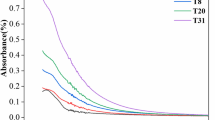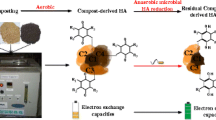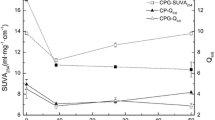Abstract
Humic substances (HSs) can ameliorate soil pollution by mediating electron transfer between microorganisms and contaminants. This capability depends on the redox-active functional structure and electron transfer capacity (ETC) of HS. This study mainly aimed to analyze the effects of different ventilation quantities on the ETC and spectral characteristics of HS (including humic acids (HAs) and fulvic acids (FAs)) during sludge composting. HS was extracted from compost with different ventilation quantities (0.1, 0.2, and 0.3 L kg−1 dry matter min−1, denoted as VQ1, VQ2, and VQ3, respectively). The ETC of HS was measured by electrochemical method. Excitation–emission matrix (EEM) spectroscopy, ultraviolet and visible (UV–Vis) spectrophotometry, and Fourier transform infrared (FT-IR) spectroscopy were conducted to understand the evolution of HS composition during composting. Results indicated that the ETC of HA and FA increased during composting, and VQ2 had stronger ETC and electron recycling rate than VQ1 and VQ3 at the end of composting. UV–Vis analysis revealed that the humification degree, aromatization degree, and molecular weight of HA and FA increased during composting, while the content of lignin decreased. EEM-PARAFAC results suggested that VQ2 accelerated the degradation of protein-like substances. FT-IR revealed a decrease trend in polysaccharide and aliphatic, and the carboxyl content increased in VQ2 and VQ3 while decreased in VQ1. Correlation analysis was used to study the relationship between HS components and ETC. The results advance our further understanding of the pollution remediation mechanism of HS.










Similar content being viewed by others
References
Ahn HK, Richard TL, Choi HL (2007) Mass and thermal balance during composting of a poultry manure—wood shavings mixture at different aeration rates. Process Biochem 42:215–223
Albrecht R, Le Petit J, Terrom G, Périssol C (2011) Comparison between UV spectroscopy and nirs to assess humification process during sewage sludge and green wastes co-composting. Bioresour Technol 102:4495–4500. https://doi.org/10.1016/j.biortech.2010.12.053
Amir S, Jouraiphy A, Meddich A, El Gharous M, Winterton P, Hafidi M (2010) Structural study of humic acids during composting of activated sludge-green waste: elemental analysis, FTIR and 13C NMR. J Hazard Mater 177:524–529. https://doi.org/10.1016/j.jhazmat.2009.12.064
Azim K, Soudi B, Boukhari S, Perissol C, Roussos S, Alami IT (2018) Composting parameters and compost quality: a literature review. Org Agric 8:141–158
Bi R, Lu Q, Yu W, Yuan Y, Zhou S (2013) Electron transfer capacity of soil dissolved organic matter and its potential impact on soil respiration. J Soils Sediments 13:1553–1560
Biyada S, Merzouki M, Elkarrach K, Benlemlih M (2020) Spectroscopic characterization of organic matter transformation during composting of textile solid waste using UV–visible spectroscopy, infrared spectroscopy and X-ray diffraction (XRD). Microchem J 159:105314. https://doi.org/10.1016/j.microc.2020.105314
Che J, Lin W, Ye J, Liao H, Yu Z, Lin H, Zhou S (2020) Insights into compositional changes of dissolved organic matter during a full-scale vermicomposting of cow dung by combined spectroscopic and electrochemical techniques. Bioresour Technol 301:122757. https://doi.org/10.1016/j.biortech.2020.122757
Chen Y, Chen Y, Li Y, Wu Y, Zeng Z, Xu R, Wang S, Li H, Zhang J (2019) Changes of heavy metal fractions during co-composting of agricultural waste and river sediment with inoculation of Phanerochaete chrysosporium. J Hazard Mater 378:120757. https://doi.org/10.1016/j.jhazmat.2019.120757
Chen T, Zhang S, Yuan Z (2020a) Adoption of solid organic waste composting products: a critical review. J Clean Prod 272:122712. https://doi.org/10.1016/j.jclepro.2020.122712
Chen W, Luo S, Du S, Zhang M, Cheng R, Wu D (2020b) Strategy to strengthen rural domestic waste composting at low temperature: choice of ventilation condition. Waste Biomass Valori 11:6649–6665. https://doi.org/10.1007/s12649-020-00943-4
Gao M, Li B, Yu A, Liang F, Yang L, Sun Y (2010) The effect of aeration rate on forced-aeration composting of chicken manure and sawdust. Bioresour Technol 101:1899–1903. https://doi.org/10.1016/j.biortech.2009.10.027
Guo X, Liu H, Wu S (2019) Humic substances developed during organic waste composting: formation mechanisms, structural properties, and agronomic functions. Sci Total Environ 662:501–510. https://doi.org/10.1016/j.scitotenv.2019.01.137
He X, Xi B, Li X, Pan H, An D, Bai S, Li D, Cui D (2013) Fluorescence excitation–emission matrix spectra coupled with parallel factor and regional integration analysis to characterize organic matter humification. Chemosphere 93:2208–2215. https://doi.org/10.1016/j.chemosphere.2013.04.039
He X, Xi B, Cui D, Liu Y, Tan W, Pan H, Li D (2014a) Influence of chemical and structural evolution of dissolved organic matter on electron transfer capacity during composting. J Hazard Mater 268:256–263. https://doi.org/10.1016/j.jhazmat.2014.01.030
He X, Xi B, Pan H, Li X, Li D, Cui D, Tang W, Yuan Y (2014b) Characterizing the heavy metal-complexing potential of fluorescent water-extractable organic matter from composted municipal solid wastes using fluorescence excitation–emission matrix spectra coupled with parallel factor analysis. Environ Sci Pollut Res 21:7973–7984. https://doi.org/10.1007/s11356-014-2751-9
He X, Yang C, You S, Zhang H, Xi B, Yu M, Liu S (2019) Redox properties of compost-derived organic matter and their association with polarity and molecular weight. Sci Total Environ 665:920–928. https://doi.org/10.1016/j.scitotenv.2019.02.164
Huang W, Li Y, Liu X, Wang W, Wen P, Yu Z, Zhou S (2021) Linking the electron transfer capacity with the compositional characteristics of dissolved organic matter during hyperthermophilic composting. Sci Total Environ 755:142687. https://doi.org/10.1016/j.scitotenv.2020.142687
Jacquin C, Lesage G, Traber J, Pronk W, Heran M (2017) Three-dimensional excitation and emission matrix fluorescence (3DEEM) for quick and pseudo-quantitative determination of protein- and humic-like substances in full-scale membrane bioreactor (MBR). Water Res 118:82–92. https://doi.org/10.1016/j.watres.2017.04.009
Jurado MM, Suárez-Estrella F, López MJ, Vargas-García MC, López-González JA, Moreno J (2015) Enhanced turnover of organic matter fractions by microbial stimulation during lignocellulosic waste composting. Bioresour Technol 186:15–24
Li M, He X, Liu J, Xi B, Zhao Y, Wei Z, Jiang Y, Su J, Hu CM (2010) Study on the characteristic UV absorption parameters of dissolved organic matter extracted from chicken manure during composting. Spectrosc Spectr Anal 30:3081–3085 (in Chinese)
Ma H, Allen HE, Yin Y (2001) Characterization of isolated fractions of dissolved organic matter from natural waters and a wastewater effluent. Water Res 35:985–996. https://doi.org/10.1016/S0043-1354(00)00350-X
Madejón P, Domínguez MT, Díaz MJ, Madejón E (2016) Improving sustainability in the remediation of contaminated soils by the use of compost and energy valorization by Paulownia fortunei. Sci Total Environ 539:401–409. https://doi.org/10.1016/j.scitotenv.2015.09.018
Marhuenda-Egea FC, Martínez-Sabater E, Jordá J, Moral R, Bustamante MA, Paredes C, Pérez-Murcia MD (2007) Dissolved organic matter fractions formed during composting of winery and distillery residues: Evaluation of the process by fluorescence excitation–emission matrix. Chemosphere 68:301–309. https://doi.org/10.1016/j.chemosphere.2006.12.075
Masmoudi S, Jarboui R, El Feki H, Gea T, Medhioub K, Ammar E (2013) Characterization of olive mill wastes composts and their humic acids: stability assessment within different particle size fractions. Environ Technol 34:787–797
McKnight DM, Boyer EW, Westerhoff PK, Doran PT, Kulbe T, Andersen DT (2001) Spectrofluorometric characterization of dissolved organic matter for indication of precursor organic material and aromaticity. Limnol Oceanogr 46:38–48. https://doi.org/10.4319/lo.2001.46.1.0038
Merlo C, Vázquez C, Iriarte AG, Romero CM (2020) Chemical and spectroscopic characterization of humic substances from sediment and riparian soil of a highly polluted urban river (Suquía River, Córdoba, Argentina). Int J Sediment Res 35:287–294. https://doi.org/10.1016/j.ijsrc.2019.10.004
Nasonova A, Levy GJ, Borisover M (2020) Bulk and water-extractable organic matter from compost: evaluation of the selective dissolution in water using infrared absorbance ratios. Environ Sci Pollut Res 27:42644–42655. https://doi.org/10.1007/s11356-020-10153-z
Peltre C, Gregorich EG, Bruun S, Jensen LS, Magid J (2017) Repeated application of organic waste affects soil organic matter composition: evidence from thermal analysis, FTIR-PAS, amino sugars and lignin biomarkers. Soil Biol Biochem 104:117–127. https://doi.org/10.1016/j.soilbio.2016.10.016
Piccolo A, Spaccini R, Nieder R, Richter J (2004) Sequestration of a biologically labile organic carbon in soils by humified organic matter. Clim Chang 67:329–343
Ren X, Wang Q, Awasthi MK, Zhao J, Tu Z, Li R, Wen L, Zhang Z (2019) Effect of tertiary-amine bentonite on carbon transformation and global warming potential during chicken manure composting. J Clean Prod 237:117818. https://doi.org/10.1016/j.jclepro.2019.117818
Said-Pullicino D, Erriquens FG, Gigliotti G (2007) Changes in the chemical characteristics of water-extractable organic matter during composting and their influence on compost stability and maturity. Bioresour Technol 98:1822–1831. https://doi.org/10.1016/j.biortech.2006.06.018
Song C, Li M, Xi B, Wei Z, Zhao Y, Jia X, Qi H, Zhu C (2015) Characterisation of dissolved organic matter extracted from the bio-oxidative phase of co-composting of biogas residues and livestock manure using spectroscopic techniques. Int Biodeterior Biodegradation 103:38–50. https://doi.org/10.1016/j.ibiod.2015.03.032
Soobhany N, Gunasee S, Rago YP, Joyram H, Raghoo P, Mohee R, Garg VK (2017) Spectroscopic, thermogravimetric and structural characterization analyses for comparing municipal solid waste composts and vermicomposts stability and maturity. Bioresour Technol 236:11–19. https://doi.org/10.1016/j.biortech.2017.03.161
Spencer R G, Butler K D, Aiken G R (2012) Dissolved organic carbon and chromophoric dissolved organic matter properties of rivers in the USA. J. Geophys. Res., 117,G03001. https://doi.org/10.1029/2011JG001928
Stedmon CA, Markager S, Bro R (2003) Tracing dissolved organic matter in aquatic environments using a new approach to fluorescence spectroscopy. Mar Chem 82:239–254. https://doi.org/10.1016/S0304-4203(03)00072-0
Stern N, Mejia J, He S, Yang Y, Ginder-Vogel M, Roden EE (2018) Dual role of humic substances as electron donor and shuttle for dissimilatory iron reduction. Environ Sci Technol 52:5691–5699. https://doi.org/10.1021/acs.est.7b06574
Strobel BW, Hansen HCB, Borggaard OK, Andersen MK, Raulund-Rasmussen K (2001) Composition and reactivity of DOC in forest floor soil solutions in relation to tree species and soil type. Biogeochemistry 56:1–26
Sun X, Li G, Xiao A, Shi H, Wang Y, Li Y (2014) Analysis on the impact of composting with different proportions of corn stalks and pig manure on humic acid fractions and IR spectral feature. Spectrosc Spectr Anal 34:2413–2418
Tang J, Wang Y, Zhao W, Ye W, Zhou S (2019) Porous hollow carbon tube derived from kapok fibres as efficient metal-free oxygen reduction catalysts. Sci China Technol Sci 62:1710–1718
Wang Y, Zhang M, Fu J, Li T, Wang J, Fu Y (2016) Insights into the interaction between carbamazepine and natural dissolved organic matter in the Yangtze Estuary using fluorescence excitation–emission matrix spectra coupled with parallel factor analysis. Environ Sci Pollut Res 23:19887–19896. https://doi.org/10.1007/s11356-016-7203-2
Wu J, Zhao Y, Qi H, Zhao X, Yang T, Du Y, Zhang H, Wei Z (2017) Identifying the key factors that affect the formation of humic substance during different materials composting. Bioresour Technol 244:1193–1196. https://doi.org/10.1016/j.biortech.2017.08.100
Wu J, Zhao Y, Yu H, Wei D, Yang T, Wei Z, Lu Q, Zhang X (2019) Effects of aeration rates on the structural changes in humic substance during co-composting of digestates and chicken manure. Sci Total Environ 658:510–520. https://doi.org/10.1016/j.scitotenv.2018.12.198
Xu W, Hu P, Zhou S, Li X, Li Y (2009) Electron shuttling function of dissolved organic matter. Environ Sci 30:2297–2301 (in Chinese)
Xu J, Jiang Z, Li M, Li Q (2019) A compost-derived thermophilic microbial consortium enhances the humification process and alters the microbial diversity during composting. J Environ Manag 243:240–249. https://doi.org/10.1016/j.jenvman.2019.05.008
Yang F, Li G, Shi H, Wang Y (2015) Effects of phosphogypsum and superphosphate on compost maturity and gaseous emissions during kitchen waste composting. Waste Manag 36:70–76. https://doi.org/10.1016/j.wasman.2014.11.012
Yang C, Zheng M, Zhang Y, Xi B, Tian Z, He X (2020) Bioreduction of hexavalent chromium: effect of compost-derived humic acids and hematite. Chin Chem Lett 31:2693–2697. https://doi.org/10.1016/j.cclet.2020.04.001
Yuan Y, Tao Y, Zhou S, Yuan T, Lu Q, He J (2012) Electron transfer capacity as a rapid and simple maturity index for compost. Bioresour Technol 116:428–434. https://doi.org/10.1016/j.biortech.2012.03.114
Yuan Y, Tan W, He X, Xi B, Gao R, Zhang H, Dang Q, Li D (2016) Heterogeneity of the electron exchange capacity of kitchen waste compost-derived humic acids based on fluorescence components. Anal Bioanal Chem 408:7825–7833. https://doi.org/10.1007/s00216-016-9885-1
Yuan Y, Xi B, He X, Tan W, Gao R, Zhang H, Yang C, Zhao X, Huang C, Li D (2017) Compost-derived humic acids as regulators for reductive degradation of nitrobenzene. J Hazard Mater 339:378–384. https://doi.org/10.1016/j.jhazmat.2017.06.047
Zang B, Li S, Michel F, Li G, Luo Y, Zhang D, Li Y (2016) Effects of mix ratio, moisture content and aeration rate on sulfur odor emissions during pig manure composting. Waste Manag 56:498–505. https://doi.org/10.1016/j.wasman.2016.06.026
Zhang C, Xi B, Zhang Q, Zhao Y, Wei Z, Jiang Y, Su J, Hu C (2021a) Application status and prospect of compost in soil remediation and quality improvement. Environ Eng 39: 11. https://doi.org/10.13205/j.hjgc.202109025 (in Chinese)
Zhang Q, Xi B, Yang J, Li S, Li X, Zhao X (2021b) Structural characteristics of fulvic acid composted with different materials. China Environ Sci 41:763–770 (in Chinese)
Zhao X, Tan W, Peng J, Dang Q, Zhang H, Xi B (2020) Biowaste-source-dependent synthetic pathways of redox functional groups within humic acids favoring pentachlorophenol dechlorination in composting process. Environ Int 135:105380
Zhou Y, Selvam A, Wong JWC (2014) Evaluation of humic substances during co-composting of food waste, sawdust and Chinese medicinal herbal residues. Bioresour Technol 168:229–234. https://doi.org/10.1016/j.biortech.2014.05.070
Zhou S, Zhang Y, Huang T, Liu YF, Zhang L, Li G, Yue L, Luo X (2019) Spectral characteristics and sources of dissolved organic matter with different relative molecular weight from rainwater from summer and autumn in thezhoucun reservoir based on UV-Vis and EEMs. Environ Sci 40:172–184 (in Chinese)
Funding
This work was financially supported by Natural Science Foundation of Guangxi (No. 2018GXNSFGA281001); Science and Technology Major Project of Guangxi (No. AA18118013); and Guangxi Science and Technology Project (No. AD18126018).
Data availability and materials
The datasets used or analyzed during the current study are available from the corresponding author on reasonable request.
Author information
Authors and Affiliations
Contributions
All authors contributed to the study conception and design. The first draft of the manuscript was written by Zhihan Tan. Material preparation, data collection, and analysis were performed by Quanyi Ouche and Yuxin Tian. Hongxiang Zhu, Xiaosong He, Beidou Xi, Xiaojie Sun, and Hongxia Zhang reviewed and edited the manuscript; all authors commented on previous versions of the manuscript. All authors read and approved the final manuscript.
Corresponding author
Ethics declarations
Ethics approval and consent to participate
Not applicable.
Consent for publication
Not applicable.
Competing interests
The authors declare no competing interests.
Additional information
Responsible Editor: Ta Yeong Wu
Publisher’s note
Springer Nature remains neutral with regard to jurisdictional claims in published maps and institutional affiliations.
Supplementary information
ESM 1
(DOC 3595 kb)
Rights and permissions
About this article
Cite this article
Tan, Z., Zhu, H., He, X. et al. Effect of ventilation quantity on electron transfer capacity and spectral characteristics of humic substances during sludge composting. Environ Sci Pollut Res 29, 70269–70284 (2022). https://doi.org/10.1007/s11356-022-20808-8
Received:
Accepted:
Published:
Issue Date:
DOI: https://doi.org/10.1007/s11356-022-20808-8




